night vision BMW M5 2013 F10 Owner's Manual
[x] Cancel search | Manufacturer: BMW, Model Year: 2013, Model line: M5, Model: BMW M5 2013 F10Pages: 230, PDF Size: 6.34 MB
Page 16 of 230
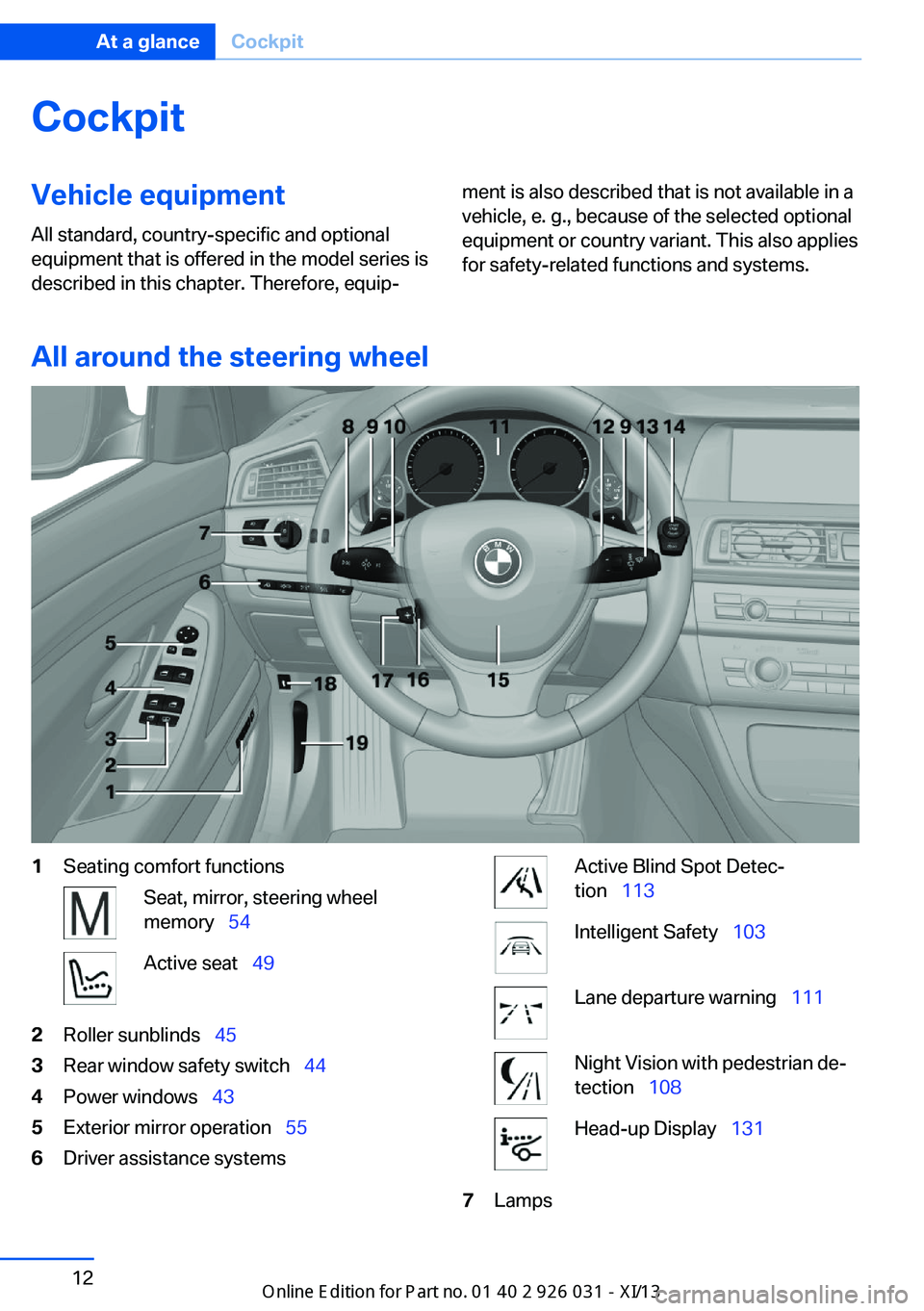
CockpitVehicle equipment
All standard, country-specific and optional
equipment that is offered in the model series is
described in this chapter. Therefore, equip‐ment is also described that is not available in a
vehicle, e. g., because of the selected optional
equipment or country variant. This also applies
for safety-related functions and systems.
All around the steering wheel
1Seating comfort functionsSeat, mirror, steering wheel
memory 54Active seat 492Roller sunblinds 453Rear window safety switch 444Power windows 435Exterior mirror operation 556Driver assistance systemsActive Blind Spot Detec‐
tion 113Intelligent Safety 103Lane departure warning 111Night Vision with pedestrian de‐
tection 108Head-up Display 1317LampsSeite 12At a glanceCockpit12
Online Edition for Part no. 01 40 2 909 953 - VI/13
Page 37 of 230
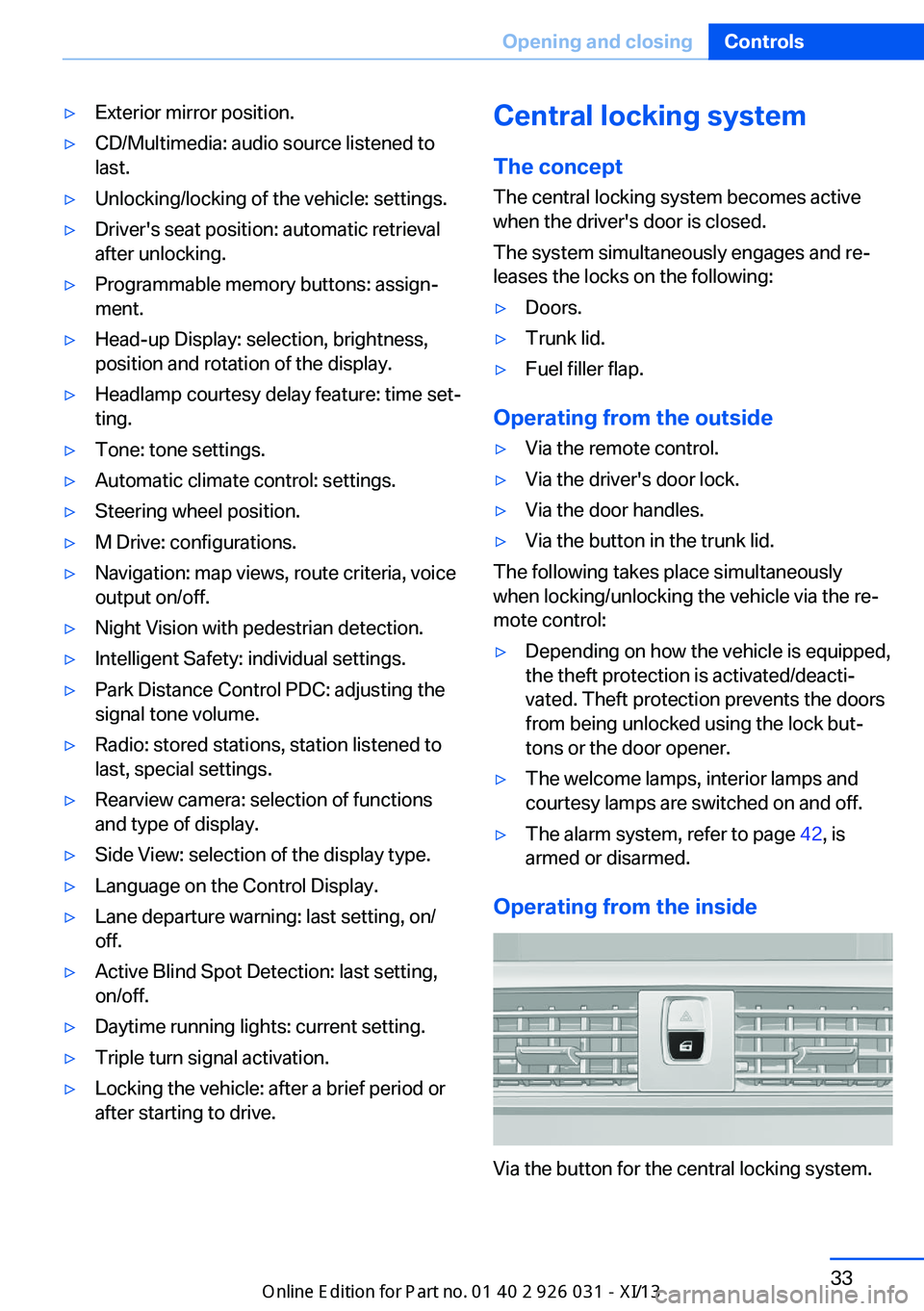
▷Exterior mirror position.▷CD/Multimedia: audio source listened to
last.▷Unlocking/locking of the vehicle: settings.▷Driver's seat position: automatic retrieval
after unlocking.▷Programmable memory buttons: assign‐
ment.▷Head-up Display: selection, brightness,
position and rotation of the display.▷Headlamp courtesy delay feature: time set‐
ting.▷Tone: tone settings.▷Automatic climate control: settings.▷Steering wheel position.▷M Drive: configurations.▷Navigation: map views, route criteria, voice
output on/off.▷Night Vision with pedestrian detection.▷Intelligent Safety: individual settings.▷Park Distance Control PDC: adjusting the
signal tone volume.▷Radio: stored stations, station listened to
last, special settings.▷Rearview camera: selection of functions
and type of display.▷Side View: selection of the display type.▷Language on the Control Display.▷Lane departure warning: last setting, on/
off.▷Active Blind Spot Detection: last setting,
on/off.▷Daytime running lights: current setting.▷Triple turn signal activation.▷Locking the vehicle: after a brief period or
after starting to drive.Central locking system
The concept The central locking system becomes active
when the driver's door is closed.
The system simultaneously engages and re‐
leases the locks on the following:▷Doors.▷Trunk lid.▷Fuel filler flap.
Operating from the outside
▷Via the remote control.▷Via the driver's door lock.▷Via the door handles.▷Via the button in the trunk lid.
The following takes place simultaneously
when locking/unlocking the vehicle via the re‐
mote control:
▷Depending on how the vehicle is equipped,
the theft protection is activated/deacti‐
vated. Theft protection prevents the doors
from being unlocked using the lock but‐
tons or the door opener.▷The welcome lamps, interior lamps and
courtesy lamps are switched on and off.▷The alarm system, refer to page 42, is
armed or disarmed.
Operating from the inside
Via the button for the central locking system.
Seite 33Opening and closingControls33
Online Edition for Part no. 01 40 2 909 953 - VI/13
Page 110 of 230
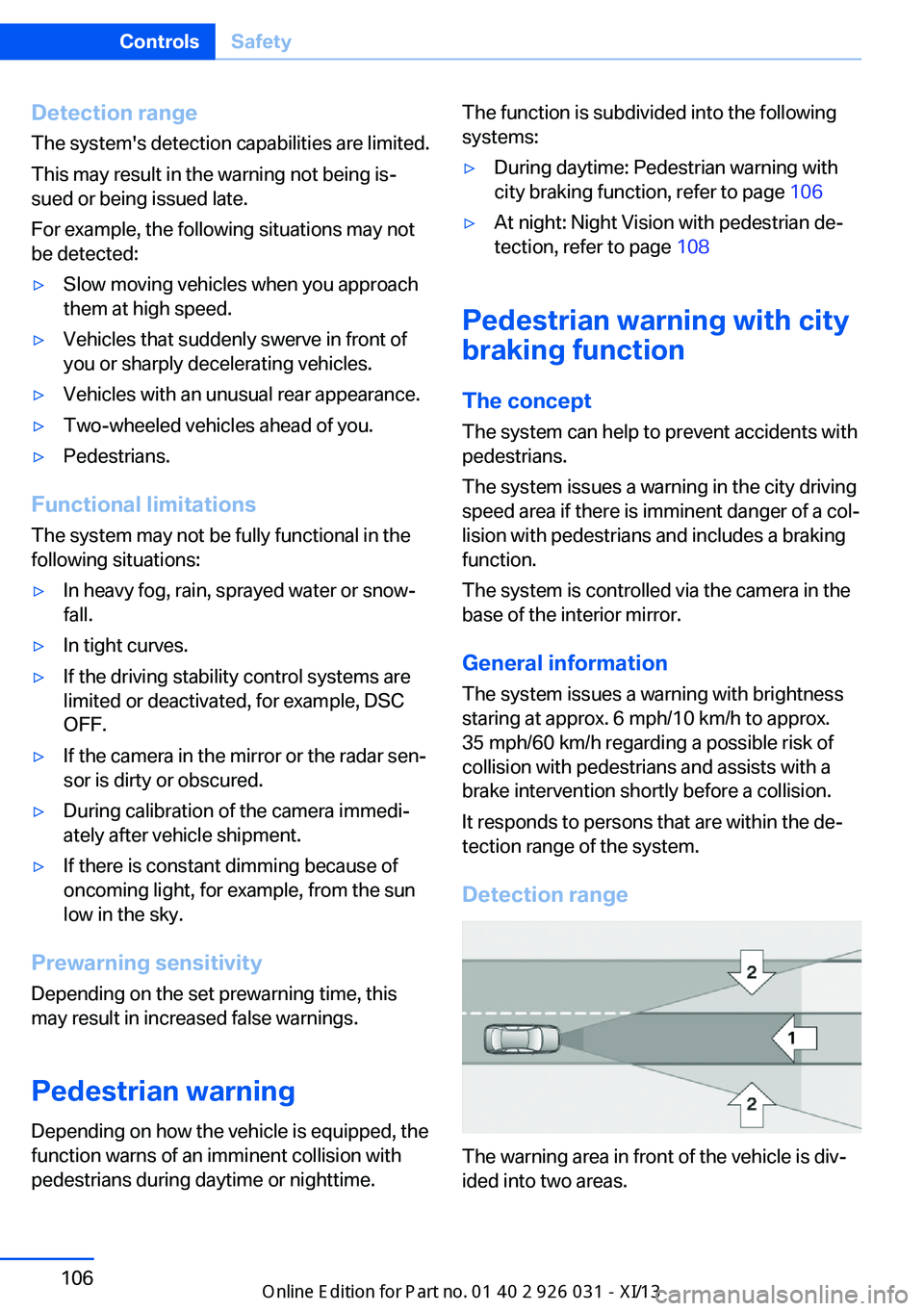
Detection range
The system's detection capabilities are limited.
This may result in the warning not being is‐
sued or being issued late.
For example, the following situations may not
be detected:▷Slow moving vehicles when you approach
them at high speed.▷Vehicles that suddenly swerve in front of
you or sharply decelerating vehicles.▷Vehicles with an unusual rear appearance.▷Two-wheeled vehicles ahead of you.▷Pedestrians.
Functional limitations
The system may not be fully functional in the
following situations:
▷In heavy fog, rain, sprayed water or snow‐
fall.▷In tight curves.▷If the driving stability control systems are
limited or deactivated, for example, DSC
OFF.▷If the camera in the mirror or the radar sen‐
sor is dirty or obscured.▷During calibration of the camera immedi‐
ately after vehicle shipment.▷If there is constant dimming because of
oncoming light, for example, from the sun
low in the sky.
Prewarning sensitivity
Depending on the set prewarning time, this
may result in increased false warnings.
Pedestrian warning
Depending on how the vehicle is equipped, the
function warns of an imminent collision with
pedestrians during daytime or nighttime.
The function is subdivided into the following
systems:▷During daytime: Pedestrian warning with
city braking function, refer to page 106▷At night: Night Vision with pedestrian de‐
tection, refer to page 108
Pedestrian warning with city
braking function
The concept The system can help to prevent accidents with
pedestrians.
The system issues a warning in the city driving
speed area if there is imminent danger of a col‐
lision with pedestrians and includes a braking
function.
The system is controlled via the camera in the
base of the interior mirror.
General information
The system issues a warning with brightness
staring at approx. 6 mph/10 km/h to approx.
35 mph/60 km/h regarding a possible risk of
collision with pedestrians and assists with a
brake intervention shortly before a collision.
It responds to persons that are within the de‐
tection range of the system.
Detection range
The warning area in front of the vehicle is div‐
ided into two areas.
Seite 106ControlsSafety106
Online Edition for Part no. 01 40 2 909 953 - VI/13
Page 112 of 230
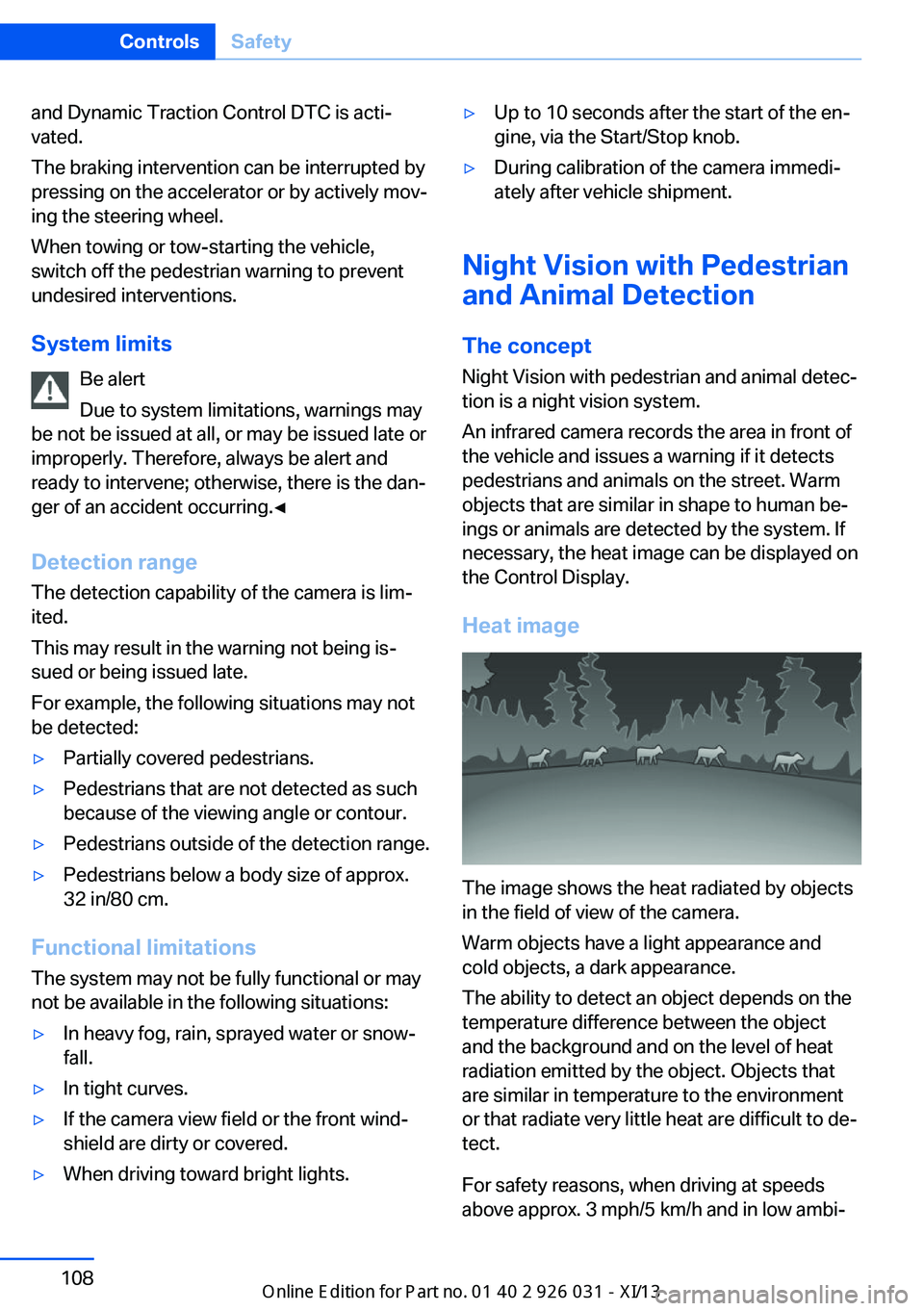
and Dynamic Traction Control DTC is acti‐
vated.
The braking intervention can be interrupted by
pressing on the accelerator or by actively mov‐
ing the steering wheel.
When towing or tow-starting the vehicle,
switch off the pedestrian warning to prevent
undesired interventions.
System limits Be alert
Due to system limitations, warnings may
be not be issued at all, or may be issued late or
improperly. Therefore, always be alert and
ready to intervene; otherwise, there is the dan‐
ger of an accident occurring.◀
Detection range
The detection capability of the camera is lim‐ ited.
This may result in the warning not being is‐
sued or being issued late.
For example, the following situations may not
be detected:▷Partially covered pedestrians.▷Pedestrians that are not detected as such
because of the viewing angle or contour.▷Pedestrians outside of the detection range.▷Pedestrians below a body size of approx.
32 in/80 cm.
Functional limitations
The system may not be fully functional or may
not be available in the following situations:
▷In heavy fog, rain, sprayed water or snow‐
fall.▷In tight curves.▷If the camera view field or the front wind‐
shield are dirty or covered.▷When driving toward bright lights.▷Up to 10 seconds after the start of the en‐
gine, via the Start/Stop knob.▷During calibration of the camera immedi‐
ately after vehicle shipment.
Night Vision with Pedestrian
and Animal Detection
The concept Night Vision with pedestrian and animal detec‐
tion is a night vision system.
An infrared camera records the area in front of
the vehicle and issues a warning if it detects
pedestrians and animals on the street. Warm
objects that are similar in shape to human be‐
ings or animals are detected by the system. If necessary, the heat image can be displayed on
the Control Display.
Heat image
The image shows the heat radiated by objects
in the field of view of the camera.
Warm objects have a light appearance and
cold objects, a dark appearance.
The ability to detect an object depends on the
temperature difference between the object
and the background and on the level of heat
radiation emitted by the object. Objects that
are similar in temperature to the environment
or that radiate very little heat are difficult to de‐
tect.
For safety reasons, when driving at speeds
above approx. 3 mph/5 km/h and in low ambi‐
Seite 108ControlsSafety108
Online Edition for Part no. 01 40 2 909 953 - VI/13
Page 113 of 230
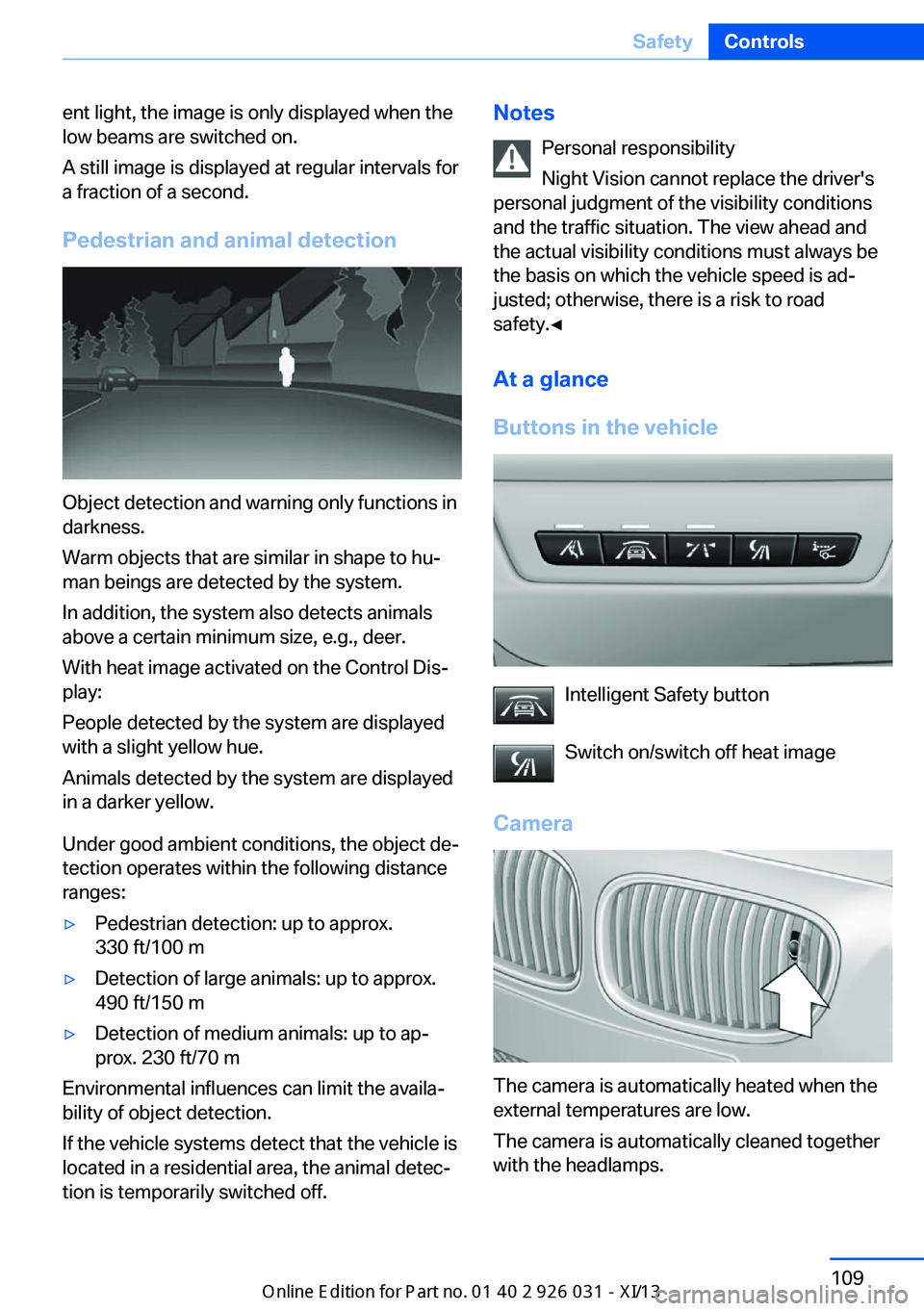
ent light, the image is only displayed when the
low beams are switched on.
A still image is displayed at regular intervals for
a fraction of a second.
Pedestrian and animal detection
Object detection and warning only functions in
darkness.
Warm objects that are similar in shape to hu‐
man beings are detected by the system.
In addition, the system also detects animals
above a certain minimum size, e.g., deer.
With heat image activated on the Control Dis‐
play:
People detected by the system are displayed
with a slight yellow hue.
Animals detected by the system are displayed
in a darker yellow.
Under good ambient conditions, the object de‐
tection operates within the following distance
ranges:
▷Pedestrian detection: up to approx.
330 ft/100 m▷Detection of large animals: up to approx.
490 ft/150 m▷Detection of medium animals: up to ap‐
prox. 230 ft/70 m
Environmental influences can limit the availa‐
bility of object detection.
If the vehicle systems detect that the vehicle is
located in a residential area, the animal detec‐
tion is temporarily switched off.
Notes
Personal responsibility
Night Vision cannot replace the driver's
personal judgment of the visibility conditions
and the traffic situation. The view ahead and the actual visibility conditions must always be
the basis on which the vehicle speed is ad‐ justed; otherwise, there is a risk to road
safety.◀
At a glance
Buttons in the vehicle
Intelligent Safety button
Switch on/switch off heat image
Camera
The camera is automatically heated when the
external temperatures are low.
The camera is automatically cleaned together
with the headlamps.
Seite 109SafetyControls109
Online Edition for Part no. 01 40 2 909 953 - VI/13
Page 114 of 230
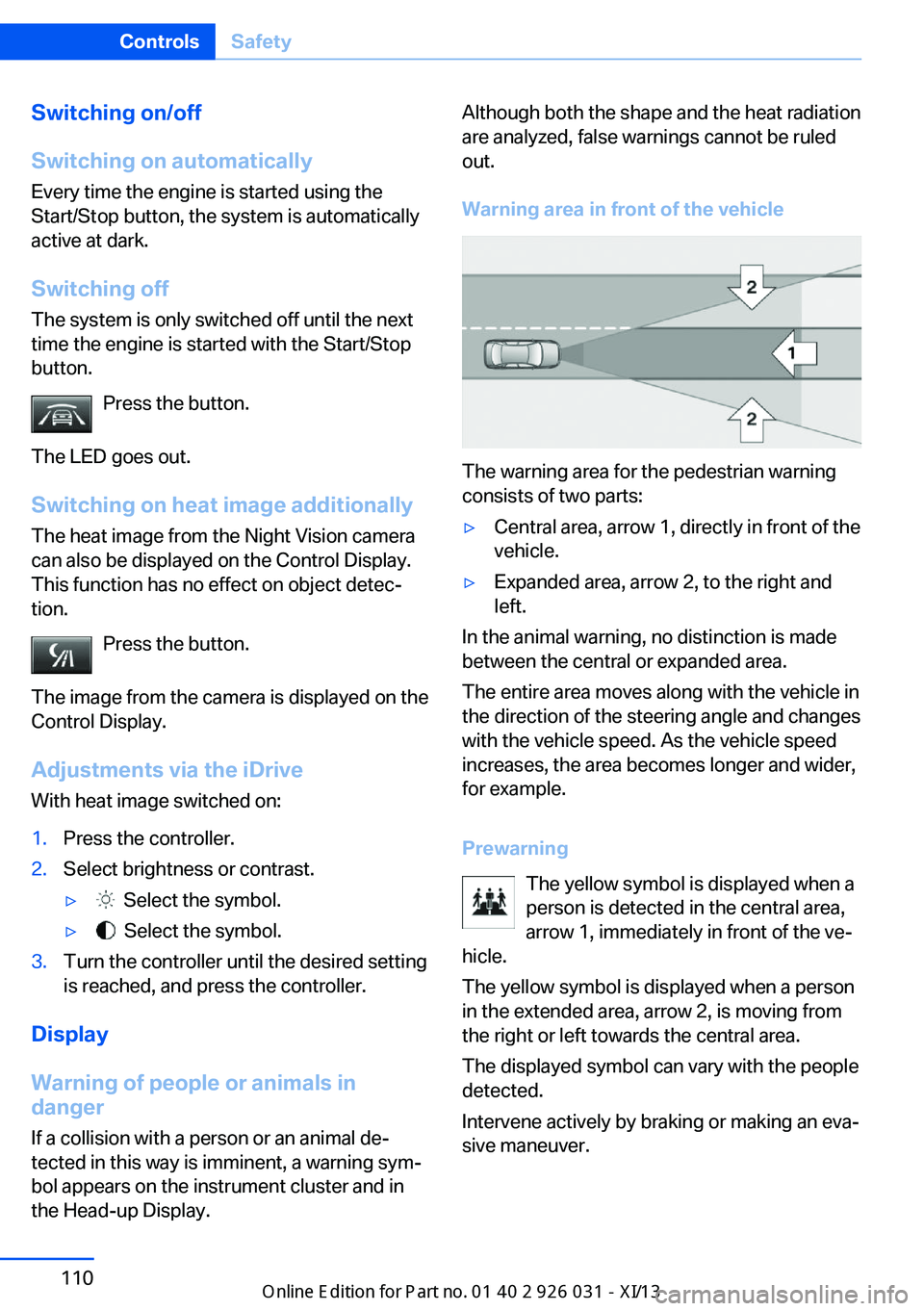
Switching on/off
Switching on automatically Every time the engine is started using the
Start/Stop button, the system is automatically
active at dark.
Switching off The system is only switched off until the next
time the engine is started with the Start/Stop
button.
Press the button.
The LED goes out.
Switching on heat image additionally The heat image from the Night Vision camera
can also be displayed on the Control Display.
This function has no effect on object detec‐ tion.
Press the button.
The image from the camera is displayed on the
Control Display.
Adjustments via the iDrive With heat image switched on:1.Press the controller.2.Select brightness or contrast.▷ Select the symbol.▷ Select the symbol.3.Turn the controller until the desired setting
is reached, and press the controller.
Display
Warning of people or animals in
danger
If a collision with a person or an animal de‐
tected in this way is imminent, a warning sym‐
bol appears on the instrument cluster and in
the Head-up Display.
Although both the shape and the heat radiation
are analyzed, false warnings cannot be ruled
out.
Warning area in front of the vehicle
The warning area for the pedestrian warning
consists of two parts:
▷Central area, arrow 1, directly in front of the
vehicle.▷Expanded area, arrow 2, to the right and
left.
In the animal warning, no distinction is made
between the central or expanded area.
The entire area moves along with the vehicle in
the direction of the steering angle and changes
with the vehicle speed. As the vehicle speed
increases, the area becomes longer and wider,
for example.
Prewarning The yellow symbol is displayed when aperson is detected in the central area,
arrow 1, immediately in front of the ve‐
hicle.
The yellow symbol is displayed when a person
in the extended area, arrow 2, is moving from
the right or left towards the central area.
The displayed symbol can vary with the people
detected.
Intervene actively by braking or making an eva‐
sive maneuver.
Seite 110ControlsSafety110
Online Edition for Part no. 01 40 2 909 953 - VI/13
Page 115 of 230
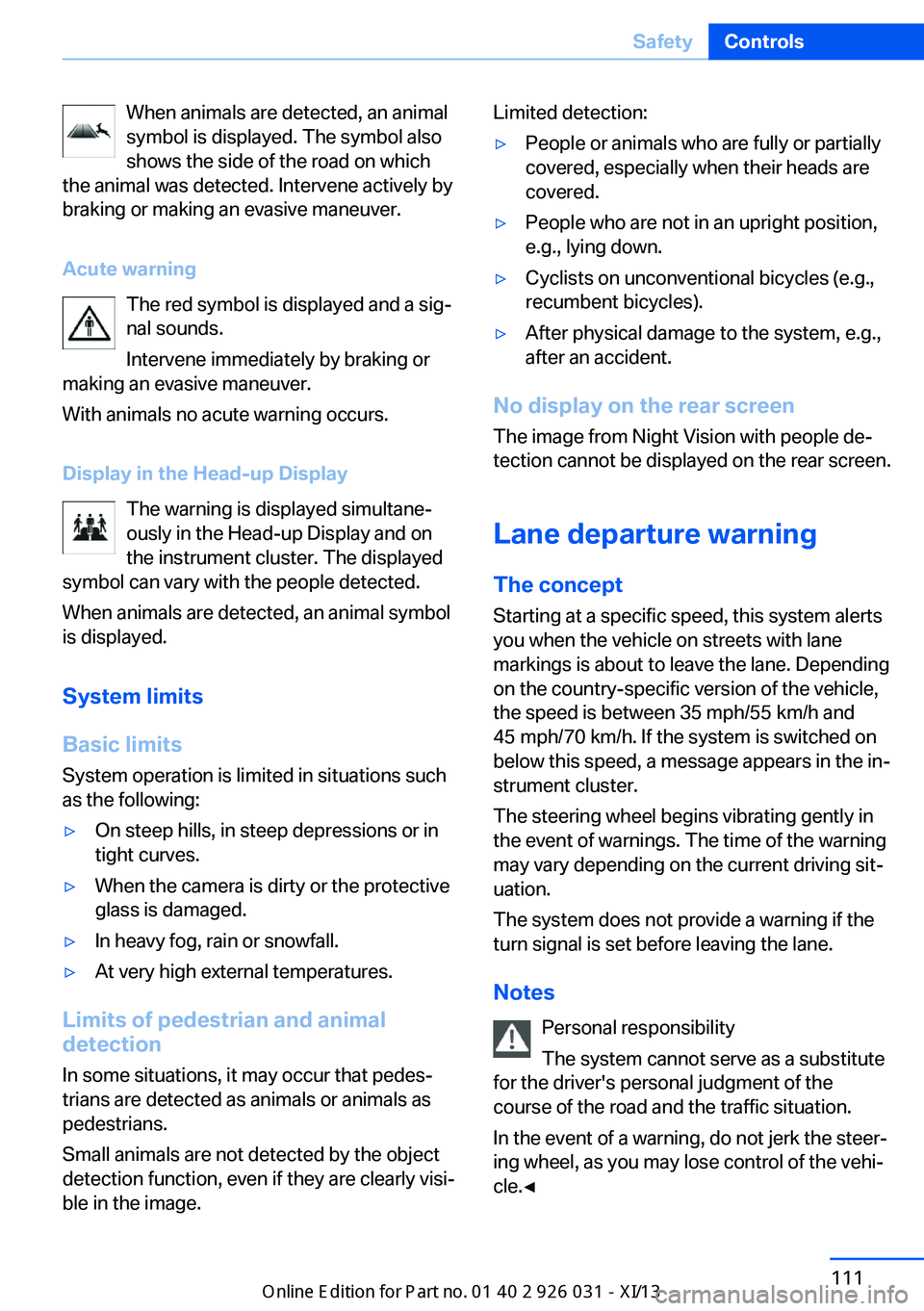
When animals are detected, an animal
symbol is displayed. The symbol also
shows the side of the road on which
the animal was detected. Intervene actively by
braking or making an evasive maneuver.
Acute warning The red symbol is displayed and a sig‐
nal sounds.
Intervene immediately by braking or
making an evasive maneuver.
With animals no acute warning occurs.
Display in the Head-up Display The warning is displayed simultane‐
ously in the Head-up Display and on
the instrument cluster. The displayed
symbol can vary with the people detected.
When animals are detected, an animal symbol
is displayed.
System limits
Basic limits
System operation is limited in situations such
as the following:▷On steep hills, in steep depressions or in
tight curves.▷When the camera is dirty or the protective
glass is damaged.▷In heavy fog, rain or snowfall.▷At very high external temperatures.
Limits of pedestrian and animal
detection
In some situations, it may occur that pedes‐
trians are detected as animals or animals as
pedestrians.
Small animals are not detected by the object
detection function, even if they are clearly visi‐
ble in the image.
Limited detection:▷People or animals who are fully or partially
covered, especially when their heads are
covered.▷People who are not in an upright position,
e.g., lying down.▷Cyclists on unconventional bicycles (e.g.,
recumbent bicycles).▷After physical damage to the system, e.g.,
after an accident.
No display on the rear screen
The image from Night Vision with people de‐
tection cannot be displayed on the rear screen.
Lane departure warningThe concept Starting at a specific speed, this system alerts
you when the vehicle on streets with lane
markings is about to leave the lane. Depending
on the country-specific version of the vehicle,
the speed is between 35 mph/55 km/h and
45 mph/70 km/h. If the system is switched on
below this speed, a message appears in the in‐
strument cluster.
The steering wheel begins vibrating gently in
the event of warnings. The time of the warning
may vary depending on the current driving sit‐
uation.
The system does not provide a warning if the
turn signal is set before leaving the lane.
Notes Personal responsibility
The system cannot serve as a substitute
for the driver's personal judgment of the
course of the road and the traffic situation.
In the event of a warning, do not jerk the steer‐
ing wheel, as you may lose control of the vehi‐
cle.◀
Seite 111SafetyControls111
Online Edition for Part no. 01 40 2 909 953 - VI/13
Page 225 of 230
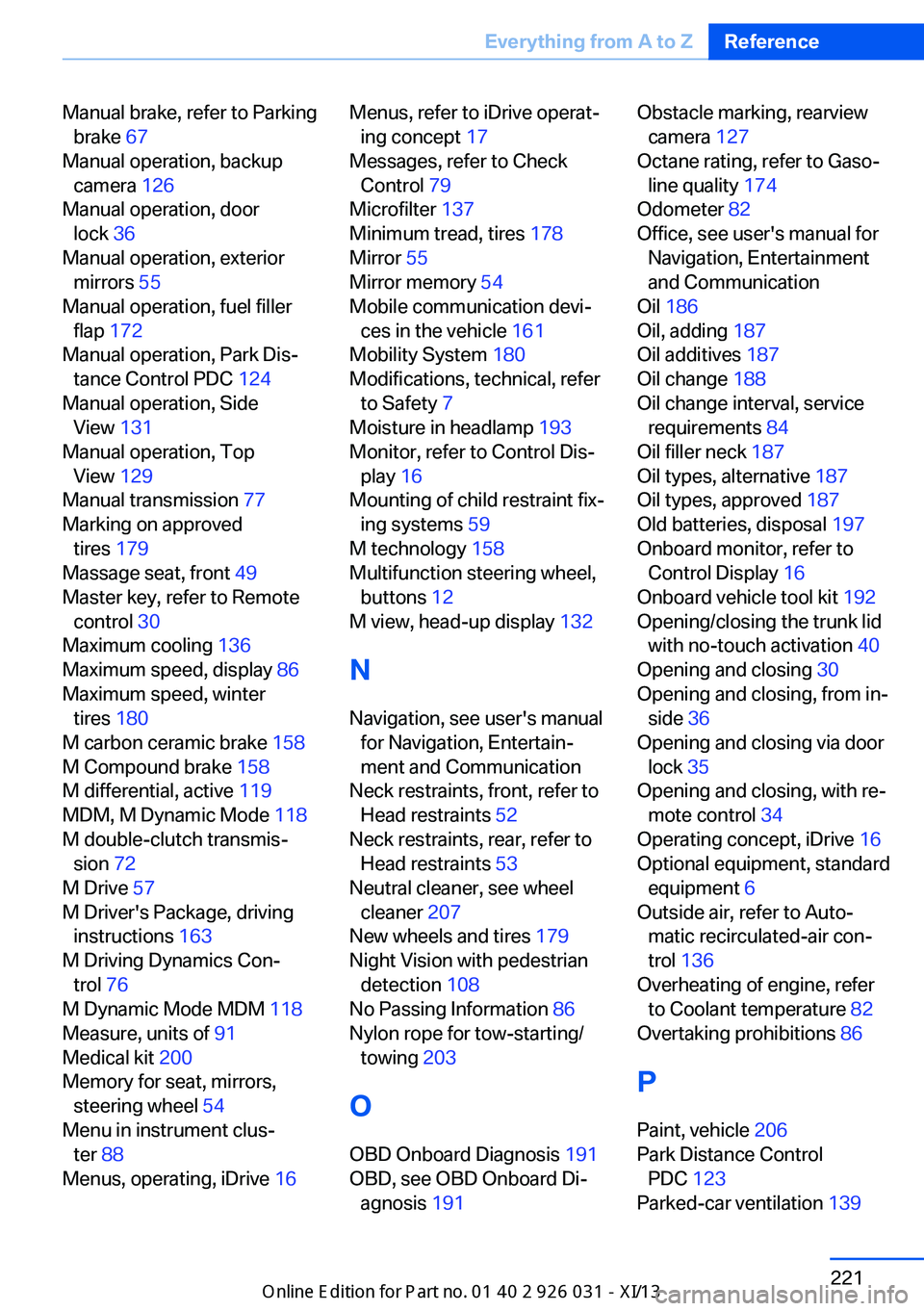
Manual brake, refer to Parkingbrake 67
Manual operation, backup camera 126
Manual operation, door lock 36
Manual operation, exterior mirrors 55
Manual operation, fuel filler flap 172
Manual operation, Park Dis‐ tance Control PDC 124
Manual operation, Side View 131
Manual operation, Top View 129
Manual transmission 77
Marking on approved tires 179
Massage seat, front 49
Master key, refer to Remote control 30
Maximum cooling 136
Maximum speed, display 86
Maximum speed, winter tires 180
M carbon ceramic brake 158
M Compound brake 158
M differential, active 119
MDM, M Dynamic Mode 118
M double-clutch transmis‐ sion 72
M Drive 57
M Driver's Package, driving instructions 163
M Driving Dynamics Con‐ trol 76
M Dynamic Mode MDM 118
Measure, units of 91
Medical kit 200
Memory for seat, mirrors, steering wheel 54
Menu in instrument clus‐ ter 88
Menus, operating, iDrive 16 Menus, refer to iDrive operat‐
ing concept 17
Messages, refer to Check Control 79
Microfilter 137
Minimum tread, tires 178
Mirror 55
Mirror memory 54
Mobile communication devi‐ ces in the vehicle 161
Mobility System 180
Modifications, technical, refer to Safety 7
Moisture in headlamp 193
Monitor, refer to Control Dis‐ play 16
Mounting of child restraint fix‐ ing systems 59
M technology 158
Multifunction steering wheel, buttons 12
M view, head-up display 132
N
Navigation, see user's manual for Navigation, Entertain‐
ment and Communication
Neck restraints, front, refer to Head restraints 52
Neck restraints, rear, refer to Head restraints 53
Neutral cleaner, see wheel cleaner 207
New wheels and tires 179
Night Vision with pedestrian detection 108
No Passing Information 86
Nylon rope for tow-starting/ towing 203
O OBD Onboard Diagnosis 191
OBD, see OBD Onboard Di‐ agnosis 191 Obstacle marking, rearview
camera 127
Octane rating, refer to Gaso‐ line quality 174
Odometer 82
Office, see user's manual for Navigation, Entertainment
and Communication
Oil 186
Oil, adding 187
Oil additives 187
Oil change 188
Oil change interval, service requirements 84
Oil filler neck 187
Oil types, alternative 187
Oil types, approved 187
Old batteries, disposal 197
Onboard monitor, refer to Control Display 16
Onboard vehicle tool kit 192
Opening/closing the trunk lid with no-touch activation 40
Opening and closing 30
Opening and closing, from in‐ side 36
Opening and closing via door lock 35
Opening and closing, with re‐ mote control 34
Operating concept, iDrive 16
Optional equipment, standard equipment 6
Outside air, refer to Auto‐ matic recirculated-air con‐
trol 136
Overheating of engine, refer to Coolant temperature 82
Overtaking prohibitions 86
P Paint, vehicle 206
Park Distance Control PDC 123
Parked-car ventilation 139 Seite 221Everything from A to ZReference221
Online Edition for Part no. 01 40 2 909 953 - VI/13
Page 226 of 230
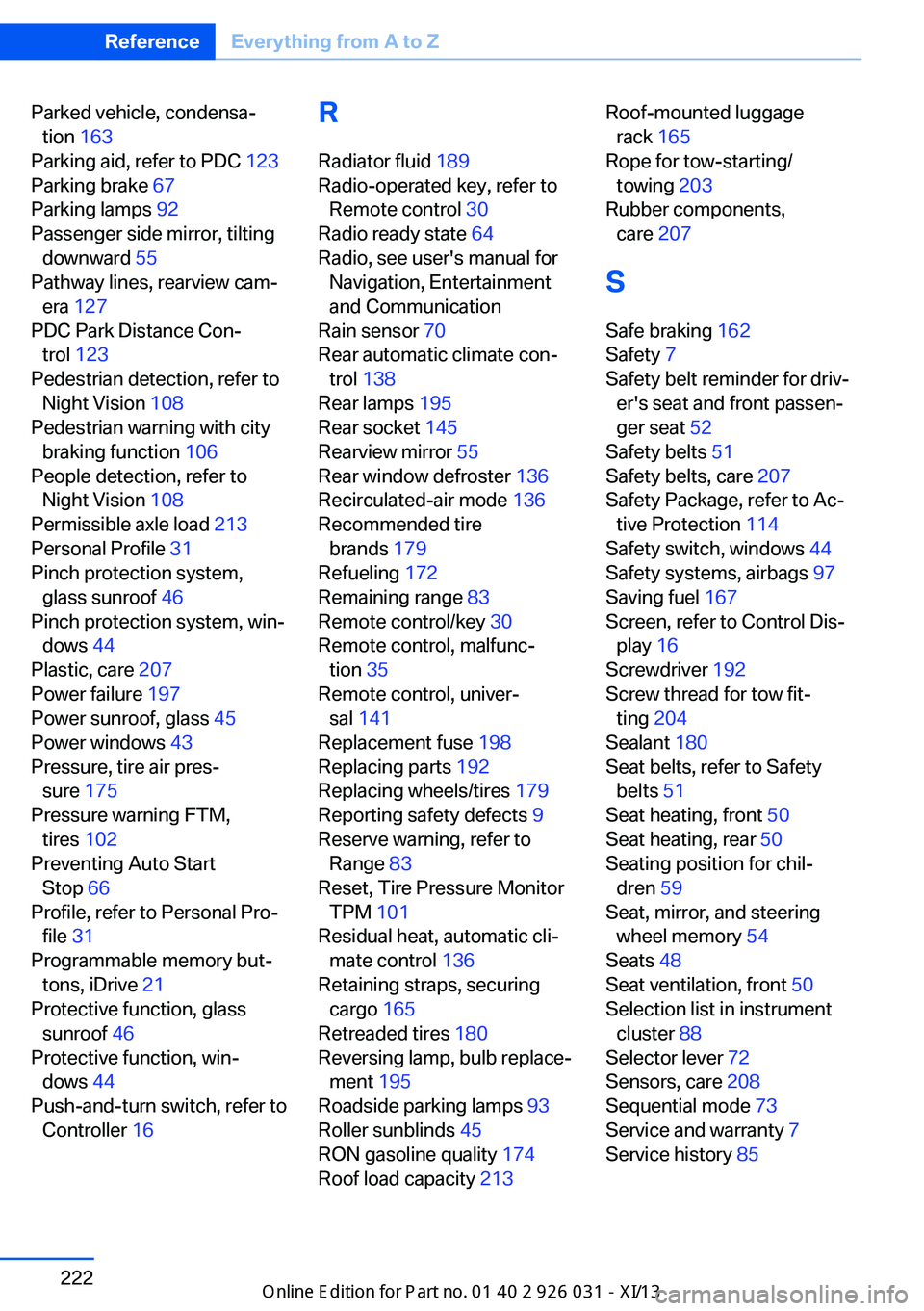
Parked vehicle, condensa‐tion 163
Parking aid, refer to PDC 123
Parking brake 67
Parking lamps 92
Passenger side mirror, tilting downward 55
Pathway lines, rearview cam‐ era 127
PDC Park Distance Con‐ trol 123
Pedestrian detection, refer to Night Vision 108
Pedestrian warning with city braking function 106
People detection, refer to Night Vision 108
Permissible axle load 213
Personal Profile 31
Pinch protection system, glass sunroof 46
Pinch protection system, win‐ dows 44
Plastic, care 207
Power failure 197
Power sunroof, glass 45
Power windows 43
Pressure, tire air pres‐ sure 175
Pressure warning FTM, tires 102
Preventing Auto Start Stop 66
Profile, refer to Personal Pro‐ file 31
Programmable memory but‐ tons, iDrive 21
Protective function, glass sunroof 46
Protective function, win‐ dows 44
Push-and-turn switch, refer to Controller 16 R
Radiator fluid 189
Radio-operated key, refer to Remote control 30
Radio ready state 64
Radio, see user's manual for Navigation, Entertainment
and Communication
Rain sensor 70
Rear automatic climate con‐ trol 138
Rear lamps 195
Rear socket 145
Rearview mirror 55
Rear window defroster 136
Recirculated-air mode 136
Recommended tire brands 179
Refueling 172
Remaining range 83
Remote control/key 30
Remote control, malfunc‐ tion 35
Remote control, univer‐ sal 141
Replacement fuse 198
Replacing parts 192
Replacing wheels/tires 179
Reporting safety defects 9
Reserve warning, refer to Range 83
Reset, Tire Pressure Monitor TPM 101
Residual heat, automatic cli‐ mate control 136
Retaining straps, securing cargo 165
Retreaded tires 180
Reversing lamp, bulb replace‐ ment 195
Roadside parking lamps 93
Roller sunblinds 45
RON gasoline quality 174
Roof load capacity 213 Roof-mounted luggage
rack 165
Rope for tow-starting/ towing 203
Rubber components, care 207
S Safe braking 162
Safety 7
Safety belt reminder for driv‐ er's seat and front passen‐
ger seat 52
Safety belts 51
Safety belts, care 207
Safety Package, refer to Ac‐ tive Protection 114
Safety switch, windows 44
Safety systems, airbags 97
Saving fuel 167
Screen, refer to Control Dis‐ play 16
Screwdriver 192
Screw thread for tow fit‐ ting 204
Sealant 180
Seat belts, refer to Safety belts 51
Seat heating, front 50
Seat heating, rear 50
Seating position for chil‐ dren 59
Seat, mirror, and steering wheel memory 54
Seats 48
Seat ventilation, front 50
Selection list in instrument cluster 88
Selector lever 72
Sensors, care 208
Sequential mode 73
Service and warranty 7
Service history 85 Seite 222ReferenceEverything from A to Z222
Online Edition for Part no. 01 40 2 909 953 - VI/13
Page 227 of 230

Service requirements, Condi‐tion Based Service
CBS 190
Service requirements, dis‐ play 84
Service, Roadside Assis‐ tance 200
Services, ConnectedDrive
Servotronic 120
Settings, locking/unlock‐ ing 41
Settings, M Drive 57
Settings on Control Dis‐ play 90
Settings, storing for seat, mir‐ rors, steering wheel 54
Shifting, manual transmis‐ sion 77
Shift Lights 75
Shoulder support 49
Side airbags 97
Side View 130
Signaling, horn 12
Signals when unlocking 41
Sitting safely 48
Size 212
Ski bag 148
Slide/tilt glass roof 45
Smallest turning circle 213
Smoker's package 143
Snow chains 183
Socket 145
Socket, OBD Onboard Diag‐ nostics 191
SOS button 199
Spare fuse 198
Speaker lighting 96
Specified engine oil types 187
Speed, average 89
Speed limit detection, on‐ board computer 89
Speed limiter, display 86
Speed Limit Information 86
Speed limit in the com‐ puter 89 Split screen 20
Stability control systems 117
Standard view, head-up dis‐ play 132
Start/stop, automatic func‐ tion 65
Start/Stop button 63
Start function during malfunc‐ tion 31
Starting the engine 64
Status display, tires 100
Status information, iDrive 20
Status of Owner's Manual 6
Steering assistance 120
Steering wheel, adjusting 56
Steering wheel heating 57
Steering wheel memory 54
Stopping the engine 65
Storage compartment, re‐ mote control 153
Storage compartments 150
Storage compartments, loca‐ tions 150
Storage, tires 180
Storing the vehicle 208
Summer tires, tread 178
Supplementary text mes‐ sage 80
Surround View 125
Switch, refer to Cockpit 12
Symbols 6
SYNC program, automatic cli‐ mate control 136
System states of the driving dynamics 84
T
Tachometer 81
Tail and brake lamps 195
Tailgate 36
Tailgate, automatic 37
Tailgate opening/closing with no-touch activation 40
Tailgate via remote con‐ trol 34 Tail lamps 195
Tail lamps, bulb replace‐ ment 195
Technical changes, refer to Safety 7
Technical data 212
Technology, BMW M 158
Telephone, see user's manual for Navigation, Entertain‐
ment and Communication
Temperature, automatic cli‐ mate control 135
Temperature display, external temperature 82
Temperature, engine oil 81
Terminal, starting aid 201
Text message, supplemen‐ tary 80
Theft alarm system, refer to Alarm system 42
Theft protection, refer to Central locking system 33
Thermal camera, refer to Night Vision 108
Through-loading system 147
Tilt alarm sensor 43
Time of arrival 89
Tire damage 178
Tire identification marks 177
Tire inflation pressure 175
Tire inflation pressure moni‐ tor, refer to FTM 102
Tire Pressure Monitor TPM 100
Tires, changing 179
Tire sealant 180
Tires, everything on wheels and tires 175
Tire tread 178
Tone, see user's manual for Navigation, Entertainment
and Communication
Tools 192
Top View 128
Total vehicle weight 213
Touchpad 18 Seite 223Everything from A to ZReference223
Online Edition for Part no. 01 40 2 909 953 - VI/13